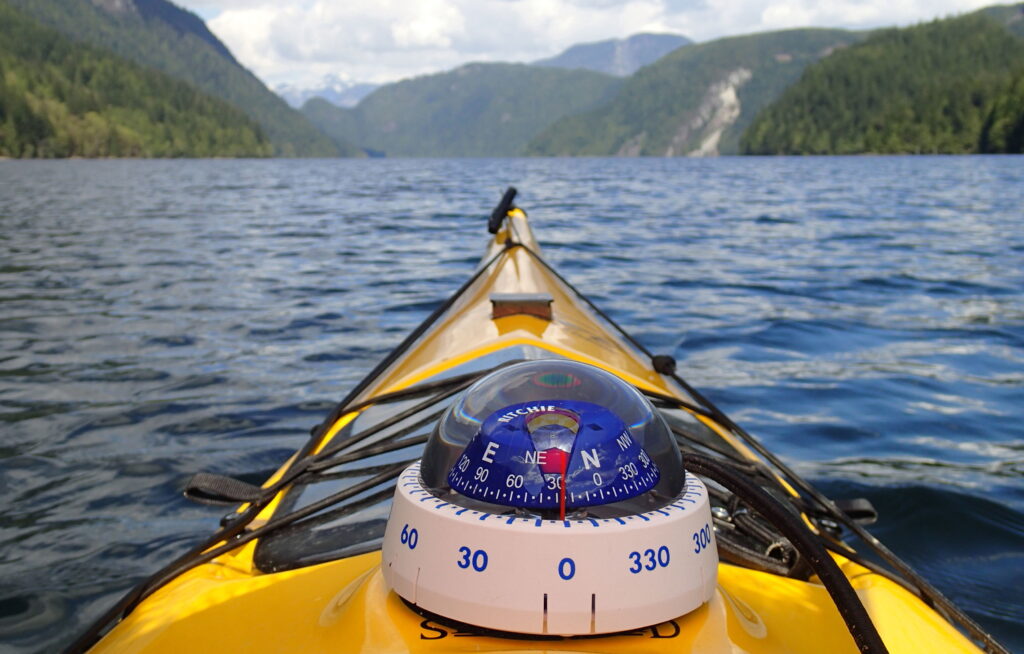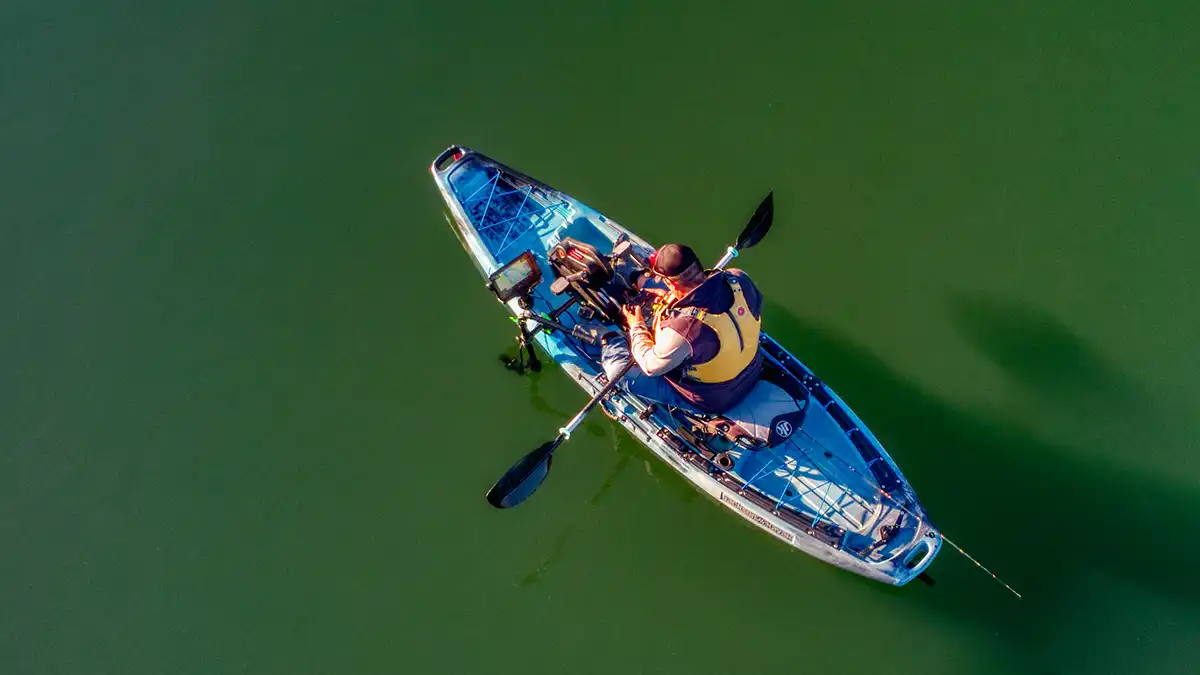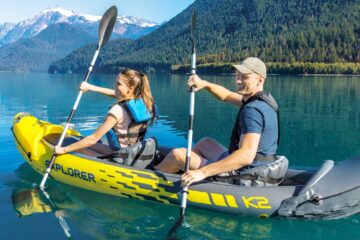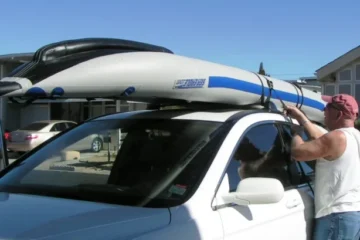Did you know kayakers can traverse over 100 miles per day with proper navigation? Kayak navigation involves planning routes, steering techniques, and maneuvering skills to paddle efficiently.
Whether you’re navigating rivers, lakes, or oceans, understanding conditions like currents and wind is key.
Learn essential navigation tips for beginners to advanced kayakers that will allow you to paddle safely and explore exciting new destinations.
Essential Navigation Skills
Navigating a kayak is like finding your way in a big outdoor adventure. Let’s learn how to use what’s around you, a compass, and maps to find your way.
Using Landmarks
- Look around for big, easy-to-see things like mountains, buildings, or trees.
- Remember these landmarks to know where you are on the water.
- If you paddle away from a big tree, for example, and want to return, just paddle back towards the tree.
Dead Reckoning
Dead reckoning is like guessing where you are when you can’t see landmarks or use a compass. You think about how fast you’re going, which way you’re headed, and for how long. Then, you guess your location.
- How it works: If you know you’re paddling at 3 miles per hour towards the north and you’ve been paddling for 2 hours, you guess you’re about 6 miles north from where you started.
- Limitations: It’s not perfect. Waves, wind, or currents can push you off course without you noticing.
Using Dead Reckoning
- Know your speed: Guess how fast you paddle in calm water.
- Watch the time: Use a waterproof watch to keep track of how long you’ve been paddling.
- Remember your direction: Keep in mind which way you started paddling.
- Make a guess: Combine all this info to guess where you might be.
Compass Basics
- A compass points north. It helps you know which way you’re going.
- The red part of the compass needle points towards the North Pole.
- Before you start, decide which direction to go. The compass will help you stay on that path.

Reading Maps and Charts
- Maps, navigation lights, and charts are like treasure maps for kayakers.
- They show water, land, and sometimes how deep the water is.
- To use them:
- Find a landmark on the map and in real life.
- This helps you know where you are.
- Draw a line on the map from where you are to where you want to go.
- Follow this line by paddling, using your compass to guide you.
Electronic Navigation
GPS devices are like magic maps that know where you are. They use satellites in the sky to find your location on Earth.
- How to use: Turn it on, wait for it to find satellites, and then it shows where you are on its screen.
- Advantages: GPS is very accurate. It can tell you exactly where you are, and how fast you’re going, and even guide you to where you want to go.
- Limitations: GPS needs batteries and can break if it gets wet or dropped. Sometimes, it can’t find satellites under thick trees or next to tall cliffs.
GPS Tips
- Learn the basics: Know how to turn it on, find your location, and use it to navigate.
- Keep it dry: Use a waterproof case or bag.
- Bring extra batteries: Always have a backup in case the first set runs out.
- Don’t rely only on GPS: Learn how to use a map and compass too. Technology can fail, but old-school skills last forever.
By using landmarks, a compass, and maps, you can explore the waters safely and have fun on your adventure.
Advanced Navigation Skills
Let’s dive into some advanced techniques to help you find your way.
Piloting Without Tools
- What it is: Using nature to guide you. Look at the sun, the stars, the wind, and the waves.
- How to do it:
- Sun and stars: In the morning and evening, the sun tells you east and west. At night, find the North Star (in the Northern Hemisphere) to find north.
- Wind and waves: Notice which way they move. They often follow the land’s shape and can guide you along a coast.
- Why it’s useful: Sometimes, you might not have a compass or GPS. Learning to read nature keeps you safe and on track.
Electronic Navigation
- Using GPS: GPS devices are super helpful for kayakers. They tell you where you are, where you’re going, and how to get there.
- Benefits: GPS is accurate and easy to use. It can store maps and routes for different trips.
- Limitations: GPS needs power and might not work well in deep valleys or thick forests. Always have a backup plan.

Dead Reckoning and Compass Use
- Combining skills: Use a compass and your knowledge of speed and time to guess your location. This is called dead reckoning.
- Steps:
- Set your course: Use a compass to find the direction you need to go.
- Know your speed: Understand how fast you paddle.
- Track time: Use a watch to see how long you’ve been moving.
- Why it matters: Even with GPS, knowing how to use a compass and dead reckon is crucial. Electronics can fail, but these skills last a lifetime.
By mastering these advanced navigation skills, you’ll be prepared for any adventure. Practice often, in different conditions, to build your confidence and expertise.
Practical Navigation Tips
Here are some cool tricks to help you master the high seas (or any adventure):
Speed and Distance:
- Be a Timekeeper: Note travel times between landmarks to gauge speed.
- Use a Logline: A rope to measure distance by counting how much unravels, then multiply for distance.
- Learn from Dolphins: Estimate speed by observing their swimming distance over time.
Foggy Dilemmas:
- Sound Alerts: Use a whistle or horn to signal your presence to others.
- Follow Your Map: Stick to a pre-marked route on your map for guidance.
- Stay Near Shore: Navigate close to land to identify landmarks more easily.
Safety First:
- Always Wear a Life Jacket: It’s your essential gear on the water.
- Inform Someone: Share your route and return time with someone reliable.
- Check the Weather: Avoid bad weather by planning with the forecast in mind.
Safety and preparedness are key. With these strategies, you’re set for safer, more efficient navigation.
Tools and Equipment for Navigation
Navigating the waters requires the right tools. Let’s explore what you need for a safe journey.
Choosing the Right Compass
- Types: Handheld, deck-mounted, and wrist compasses.
- Uses: Helps you find direction. Deck-mounted compasses are great for kayaks because you can see them easily while paddling.
GPS Devices for Kayaking
- Recommendations: Look for waterproof, durable GPS devices. Garmin and Magellan offer models designed for outdoor activities.
- Tips:
- Keep it charged.
- Learn to use it before your trip.
- Attach it securely to your kayak.
Waterproof Maps and Chart Protectors
- Why Important: Water can ruin maps and charts. Keeping them dry helps you stay on course.
- Solutions:
- Use waterproof cases or bags.
- Laminated maps resist water.
- Keep them in an easy-to-reach spot.

With the right compass, a reliable GPS, and waterproofed maps, you’re all set for navigation.
Closing Words
Mastering kayak navigation enhances your paddling experience, ensuring safety and efficiency on the water. From using natural cues and traditional tools like compasses and maps to leveraging modern GPS technology, there’s a method for every skill level.
Equip yourself with the right tools, practice regularly, and always prioritize safety to embark on thrilling and secure kayaking adventures.
FAQs
Kayak tracking refers to monitoring the path and speed of a kayak, often using GPS devices, to ensure accurate navigation and safety on the water.
Yes, there are GPS devices designed for kayaking. These waterproof and durable units help kayakers navigate, track their route, and monitor speed and distance.
Navigation lights on a kayak should be placed to ensure visibility from all directions. Typically, a white light is mounted on the kayak’s stern or worn by the paddler.
The three navigation lights are red (port side), green (starboard side), and white (stern). These lights help indicate the kayak’s direction and position at night.




